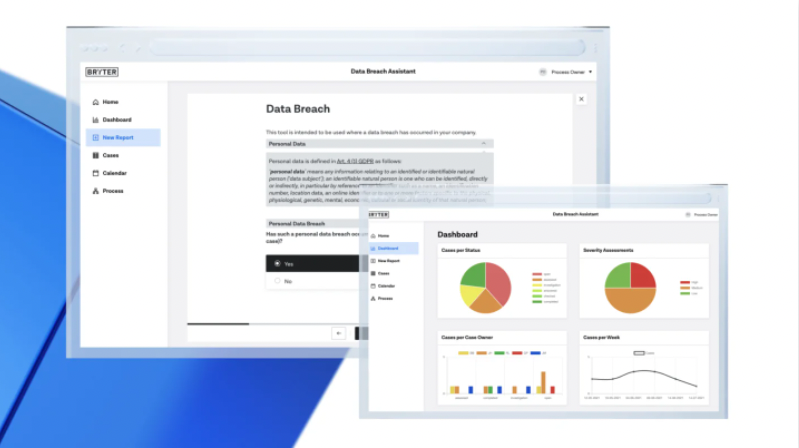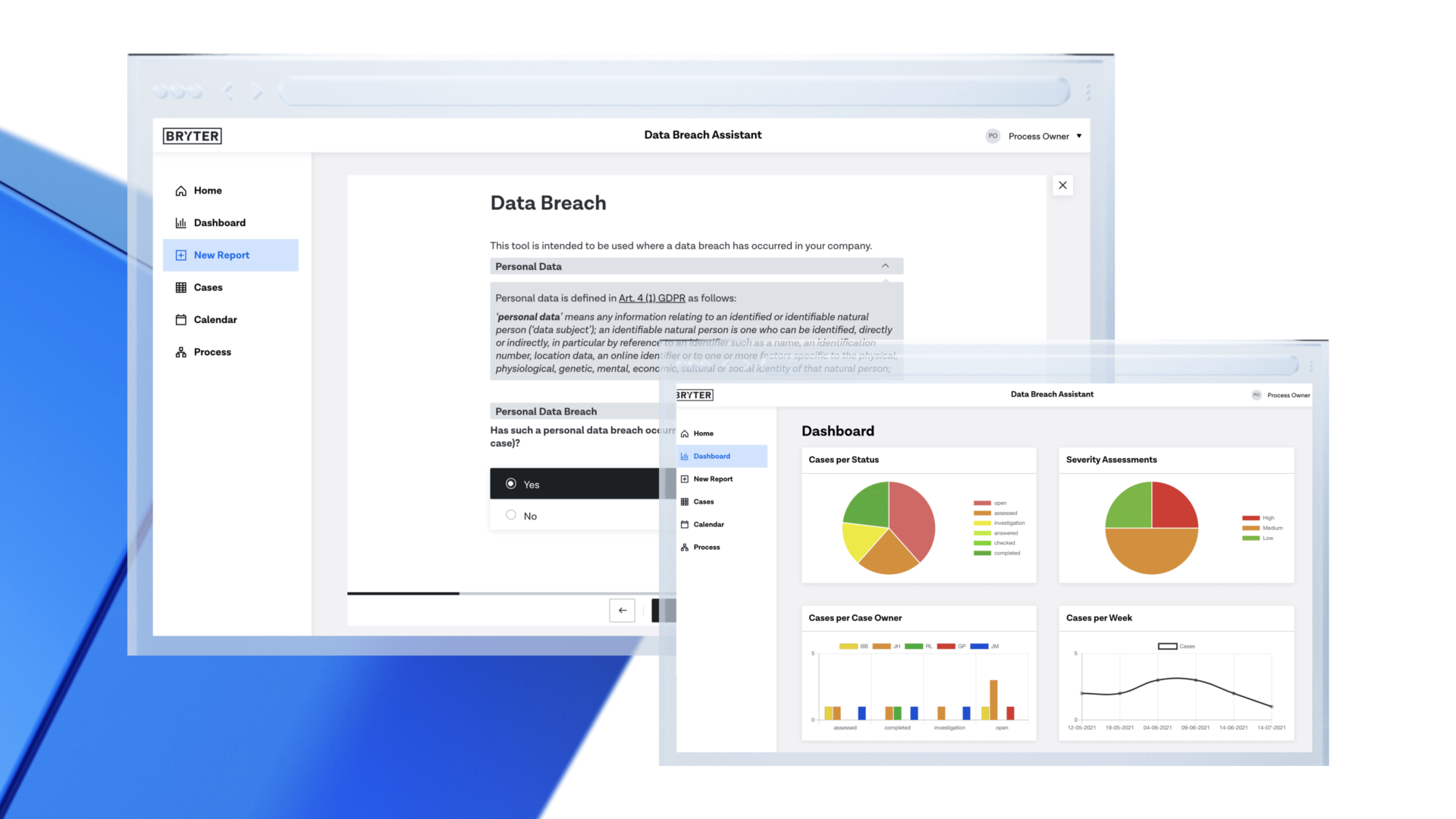GDPR compliance is high on the priority list for organizations operating in the EU or processing the personal data of anyone residing in the EU. With a vast set of rules encompassing the secure storage and management of personal data, remaining compliant by relying on manual effort alone is impractical and risky.
Large fines for violators are also top-of-mind: British Airways, for example, was fined a proposed $230 million in 2019 for an incident that compromised their customers’ data. Amazon Europe was fined €746 million for non-compliance with GDPR principles in their advertising in 2021.
Digital applications can help corporate compliance teams ensure that the right processes are being applied and maintained across the organization. But how do you select the right tool for your organization’s needs? Read on to find out what GDPR compliance software can do and what to look for when selecting your organization’s digital toolset.
Table of contents
What is GDPR?
GDPR stands for General Data Protection Regulation. It is the EU law on data protection and privacy for all individual citizens of the European Union (EU) and the European Economic Area (EEA) and came into force on 25 May 2018.
The GDPR aims to give control to individuals over their personal data and to simplify the regulatory environment for international business by unifying the regulation within the EU. It does so in part by restricting the types of personal data that an organization is allowed to collect and store to only what is absolutely necessary for business purposes, and by setting strict requirements for the security of stored data.
Who does GDPR apply to?
GDPR applies to any organization operating within the EU or doing business with (or storing data from) residents of the EU. The GDPR also addresses the transfer of personal data outside the EU and EEA areas, implicating organizations in the UK, North America, and anywhere else that does business with EU residents or collects their data — regardless of where the data is processed.
Since GDPR rules came into effect, individuals in the EU have been able to make requests of companies for copies of all personal data that has been stored on them – as well as how the organization is using the data, who they are sharing it with, and where it came from. They can also request that the company delete the information. These requests are called Subject Access Requests (SARs) and must be responded to and actioned promptly (within about one month, in most cases) and free of charge.
Typically, each of these requests are handled on a case-by-case basis, and organizations are required to take reasonable steps to comply which vary by company and industry; in many situations the correct action for an organization is impacted by other laws around how long data must be kept (for example, when a bank cannot delete financial records at a customer’s request due to laws around how long this information must be stored). Managing these complicated processes often requires custom solutions.
- Adhering to Article 25 of the GDPR, which requires data protection to be designed into the development of business processes for products and services.
- Inconsistencies across the organization in dealing with data compliance.
- Lack of automation: The majority of tasks and processes are still manual, take up valuable time, and increase costs.
- Lack of IT support: Departments outside of IT may struggle with obtaining the necessary resources to deal with GDPR compliance digitally.
- Lack of transparency: Manual and disconnected processes are often difficult to track.
- Increased risk: The lack of transparency results in potentially higher unknown risks that a compliance process has not been followed.
- Lack of KPIs: Without a digitized process, compliance functions struggle to appropriately measure their performance metrics, impact on the business and develop a reporting structure.
What is GDPR compliance software?
GDPR software is an umbrella term for a category of tools that facilitate the management of customer data, consent forms, and data security – the main requirements of GDPR. These tools can be used to address many of the challenges above.
Some GDPR tools record compliance activity and provide useful audit trails. They can also be used to automatically report on data breaches, conduct a gap analysis to identify weaknesses in the organization’s compliance strategy, or manage a Subject Access Request.
How to choose the best GDPR compliance software
The best GDPR compliance software is adaptable as interpretations of regulations change, customizable to unique company needs and policies, and can be integrated into a wide range of environments. BRYTER, for example, is a no-code platform that can be used by anyone to create tools for GDPR and other business solutions. Using a simple point-and-click interface, compliance teams can build custom GDPR tools quickly and at low cost.
By enabling data privacy automation, BRYTER helps organizations build GDPR into the business processes for products and services. When processes are designed with a GDPR compliance checklist in mind, organizations can demonstrate accountability more swiftly, and show that they are compliant or working towards compliance.
These tools built on BRYTER can help streamline GDPR compliance in a variety of ways:
- Scenario-based tools: BRYTER can automate highly interdependent and conditional scenarios typical for GDPR compliance work, including data breach reporting assistants.
- User identification: BRYTER can also help process requests regarding individual’s personal data in a fast, transparent and efficient way – ensuring compliance with GDPR. Create a Subject Access Request Assistant to enable organizations to easily gather all information necessary to verify a person’s identity, find their data and records on their systems, and respond to a request for their personal data file within the statutory timeframe.
- Customized output: The BRYTER GDPR Cyber Security Checklist Generator combines logic with content to generate bespoke outputs such as documents, reports, emails and more.
- Measure Compliance’s impact: BRYTER offers rich user analytics to understand how business users are interacting with your compliance applications
Employees can ensure they are adhering to their organization’s overall compliance framework and process across the organization, streamline the handling of compliance matters, and collaborate with all stakeholders across business units. Ultimately, this allows compliance teams to ensure that the right processes and policies are being applied and maintained across the organization.

BRYTER is interoperable and integrates with all major tech providers to enable you to create integrated solutions for your compliance needs. It can also connect to existing IT-infrastructure and data bases to formulate structured data while meeting the highest standards for performance and security, and is easily updated as regulations and company policies change.
FAQs about GDPR Compliance Software
GDPR stands for General Data Protection Regulation. It is the EU law on data protection and privacy for all individual citizens of the European Union (EU) and the European Economic Area (EEA) and came into force in 2018.
GDPR software is an umbrella term for a category of tools that facilitate the management of customer data, consent forms, and data security – the main requirements of GDPR.
Software can automatically collect and store data, which makes compliance with GDPR data storage requirements significantly easier and, often, more secure than manual alternatives.
The legal and compliance teams at most large organizations impacted by GDPR make use of some form of GDPR software to ensure compliance and avoid penalties.
How to get started with the best GDPR compliance tools for your business
GDPR requirements are wide-ranging and, like other regulations, undergo frequent updates as circumstances around data privacy and technology change – which adds to the challenge of staying compliant.
While GDPR compliance is never easy, it can become more manageable with less time and work by using the right tools. Introducing automation to GDPR processes is a proven way to reduce the risk of non-compliance and prevent or minimize the impact of data breaches while saving time and effort.
To learn how you can quickly and easily build self-service apps without coding skills, book a demo with one of our experts today. Or if you’d like to know how you can streamline your services, check out our guides to No-Code and Workflow Automation.















